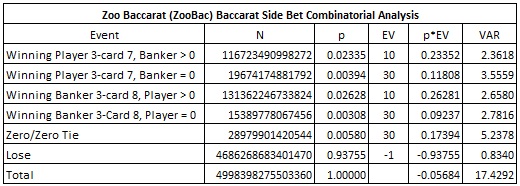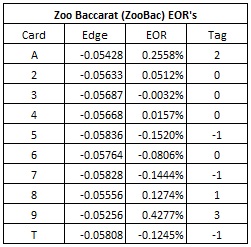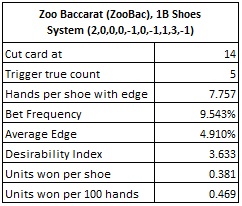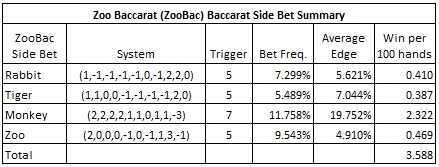Card Counting Zoo Baccarat (ZooBac)

ZooBac is a collection of four independent baccarat side bets, the Rabbit (see this post), Tiger (see this post), Monkey (see the zero/zero tie in this post) and the Zoo. This post covers card counting the Zoo side bet and also summarizes a team approach to playing against the entire ZooBac collection of four side bets.
In a previous post, I noted that I had never seen a rabbit in a zoo. I take that back. I visited a zoo while here in Asia and they had a bunny collection which included a “giant rabbit” that was pretty small. They also showcased exotic rats, roosters, dogs and the rest of the Chinese Zodiac. When I walked past the cockroach collection, I decided this was the best zoo I had ever visited.
Back to this Zoo, not that Zoo. The Zoo side bet uses the same winning hands as the Rabbit, Tiger and Monkey put together. To remind you:
- The Rabbit side bet wins when the Player hand beats the Banker hand with a three-card total of seven. There is a bonus if the Banker hand totals 0.
- The Tiger side bet wins when the Banker hand beats the Player hand with a three-card total of eight. There is a bonus if the Player hand totals 0.
- The Monkey side bet wins when the hand ends in a zero/zero tie.
The Zoo side bet is simply a combination of these three wagers into a single side bet. The player wins if any of these outcomes (Rabbit, Tiger or Monkey) occur. Here is the combinatorial analysis, which includes the payouts:

In particular:
- The house edge of the Zoo is 5.684%.
- The hit frequency of the Zoo is 6.245%.
- The standard deviation of the Zoo is 4.174.
There is little heuristic guidance to card counting the Zoo. At first glance, the only obvious card is the 9. Nines make naturals, killing the hand after the first two cards so that a Rabbit, Tiger and Monkey cannot occur. It follows that the edge moves towards the player side as 9’s are dealt from the shoe. The same does not hold for 8’s because these are useful in making three-card totals of 8 (Tiger), which are winning hands. There is another card whose value in counting the Zoo is intuitively obvious, but I didn’t “intuit it” until after I looked at the EORs. See if you can guess it before reading on.
The following table gives the EOR’s for the Zoo along with a card counting system based on these EOR’s. The betting correlation (BC) for this system is 0.985, which is quite good.

Based on these numbers, in hindsight it becomes obvious that the Ace is also a valuable card. It is impossible to draw an Ace and make a three-card Player 7, a three-card Banker 8 or a three-card total of zero. In other words, you can’t win with an Ace in your hand.
The following table gives the results of a simulation of one billion (1,000,000,000) eight-deck shoes, using the count system given above:

By itself, the Zoo side bet returns a modest 0.469 units per 100 hands. With a $100 wager whenever the count is +5 or higher, the AP will earn about $46.90 per 100 hands. With a desirability index (DI) of 3.633, it is highly unlikely that an AP will target the Zoo side bet, by itself. The game protection problem with ZooBac arises with a team approach.
Assume four APs decide to work together to card count ZooBac. Each member of the team takes one of the four side bets (Rabbit, Tiger, Monkey, Zoo) and learns the specific card counting system for his side bet. The four play together at the table. Whenever one teammate makes a wager on the side bet he is counting, the rest of the team follows suit and makes the same wager. In this way, each team member gets the full benefit of playing against all four wagers.
Here is the analysis of this team approach:

Each team member will earn 3.588 units per 100 hands. With a $100 wager, each team member will earn $358.80 per 100 hands. The team together will earn $1435 per 100 hands. Although the Rabbit, Tiger and Zoo wagers have low vulnerability, this group of four wagers (which includes the highly profitable Monkey), taken together, are highly vulnerable to a team approach.
The game-protection lessons that baccarat teaches us repeat like the cycles of the Chinese Zodiac. It’s the year of the Horse, not the year of the baccarat advantage play team. Let’s celebrate prosperity, but let’s not give it away.


